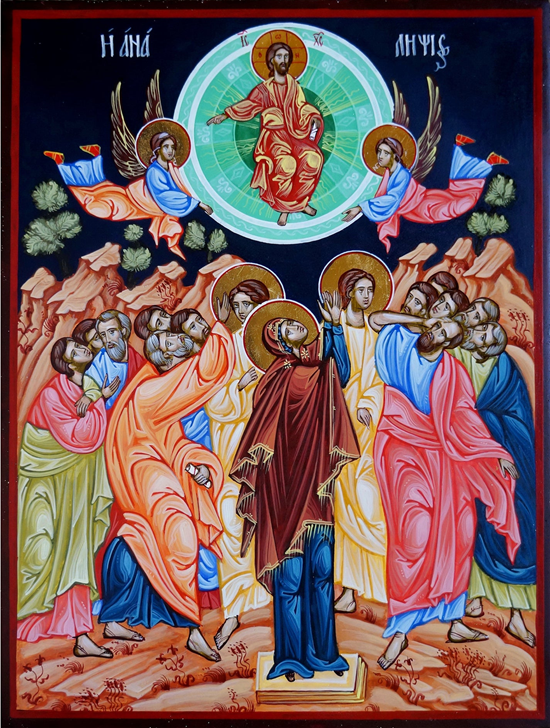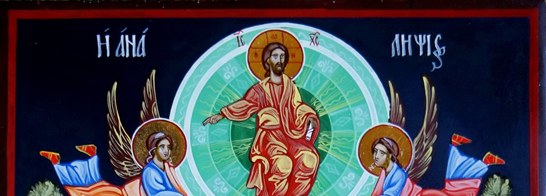Witness to the Ascension
Solemnity of the Ascension Scripture Readings

This Solemnity of the Ascension of the Lord is the one aspect of our Christian faith that I, personally, have the most difficulty wrapping my head around. I think my difficulty comes from the fact that I can’t accept the notion of a heavenly elevator taking Jesus up into the sky, and also because, rather than being a strictly historical event like the crucifixion, I think the Ascension is simply one element of an ongoing process. I’ll try to explain.
The image that we find in our first reading from Saint Luke’s Acts of the Apostles—Jesus being lifted up with a cloud taking him from their sight—is a direct reference to the Son of Man pictured in the Book of the Prophet Daniel [7:13-14]. It’s important to become familiar with this passage because it directly relates to the meaning of the Ascension. Here it is:
“As the visions during the night continued, I saw coming with the clouds of heaven One like a son of man. When he reached the Ancient of Days and was presented before him, he received dominion, splendor, and kingship; all nations, peoples, and tongues will serve him. His dominion is an everlasting dominion that shall not pass away, his kingship, one that shall not be destroyed.”
The more carefully you read the passage from Acts, the more you will see there the same themes: the reign of God and its extension to all nations. The conclusion of the passage from Acts gives further clues to its significance. The two men in white garments are reflections of the two men whom the women found in the tomb on Easter morning according to Luke’s gospel. They even echo similar words: in the gospel, “Why do you seek the living one among the dead?” and here, “Why are you standing here looking up at the sky?” Only here, they proclaim that Jesus is the Son of Man prophesied by Daniel. “This Jesus who has been taken up from you into heaven will return in the same way as you have seen him going into heaven.
We must set aside our assumptions about heaven being a place. It’s not. Heaven is the condition of living in perfect harmony and unity with God and one another. The Ascension is a kind of lesson for believers to understand the role of Jesus as Messiah—the anointed king—in the reign of God. The Ascension of Jesus is inseparable from the crucifixion, death, resurrection of Jesus and the coming of the Holy Spirit. Although it’s lived out in time, it’s actually a single, transtemporal event. That’s what I meant when I said that the Ascension was simply one element of an ongoing process. That element is the union of the Christ with the Father and his exaltation as King of kings and Lord of lords.
The exaltation of Jesus is the reverse of human exaltation. On the human plane, exaltation involves acquiring wealth, status, prestige, and political power. The exaltation of Jesus that we celebrate today begins with his condemnation and being raised up on the cross. It’s a sign of contradiction—the ultimate counter-culture statement—to see Christ’s execution as his exaltation. The faithless world cannot see it. Only the faithful can be witnesses of what the world cannot see. The Ascension takes place out of secular time. In sacred time, the passage of hours, days, or years is irrelevant. The Acts of the Apostles says that Christ’s exaltation took place after forty days—but we know that forty is a symbolic number meaning completion. For John, the resurrection exaltation, and gift of the Holy Spirit happen all at once on Easter Sunday. Who’s right? Both are, because this trans-historical event takes place in sacred time, which means that it’s ongoing. Don’t look for the return of Jesus in secular time, because it’s happening even now.
So, what can we possibly say about the Ascension, since it’s happening outside of secular time and place? Who are the disciples who bear witness to the Ascension and Christ’s exaltation with the Father forever? We are. We are witnesses to the reality that in the spiritual world—the real world—God raises up those who are worthless, contemptible, and powerless in the secular world’s estimation, and God exalts them in his glory. We mustn’t forget that Christ is our pioneer. Where he has gone, we follow. The Ascension of Christ into the glory of the Father is our destiny, also. We are, after all, the Body of Christ, crucified, risen, exalted in glory, and united with the Father and the Son and with one another by the power of the Holy Spirit. We are the community of witnesses we call the Church.
How can this be? Where is the “dominion, splendor, and kingship” promised by Daniel? Where is that “dominion [that] is an everlasting dominion” and that kingship “that shall not be destroyed” he spoke of? Unless we are followers of Christ in his suffering, death, and resurrection, how can we be witnesses of his Ascension to the Father and exaltation? Just like the resurrection, the Ascension isn’t visible to the eyes of the world. It’s visible only to those with the eyes of faith—those who believe. For God, belief doesn’t follow upon proof, but rather the opposite. Proof follows belief. “Whoever believes will be saved,” Jesus tells us. Saved from what? From the futility of living by and for ourselves alone. “Whoever does not believe will be condemned,” Jesus says. Condemned by whom? Sure not by God. No, for the faithless, they condemn themselves to a life of futility, chasing after goals that can never be achieved by selfish self-interest.
So, there you have it. The Ascension is nothing less than our public witness to the fact that God raises up and exalts the lowly and helpless who have surrendered themselves into his care and who extend that care to others. Who are those lowly and helpless? If we’re honest, we all are. We’re powerless to get through this life without reliance on something greater than ourselves—someone we encounter as our God. The Ascension of Jesus into heaven is God’s promise that our faith in him is not in vain.
Get articles from H. Les Brown delivered to your email inbox.
